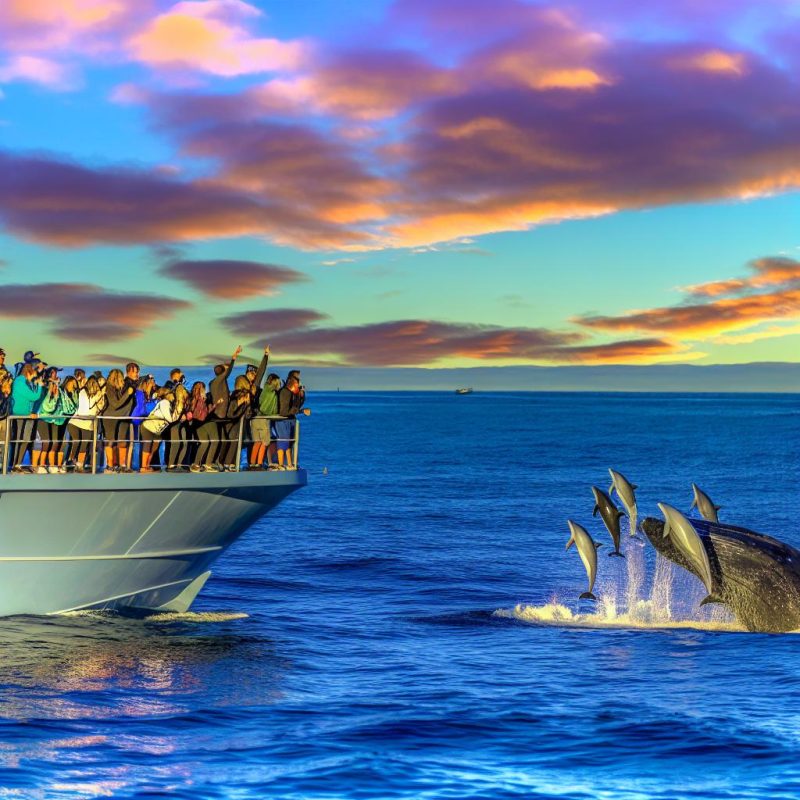Whale and dolphin watching tours provide an opportunity to observe these magnificent marine creatures in their natural habitats. These tours not only offer a chance to witness the beauty of marine life but also play a role in promoting conservation awareness. These activities occur in various locations worldwide, from cold northern seas to the warm waters of the tropics.
Significance of Whale and Dolphin Watching
Whale and dolphin watching tours have become increasingly significant, as they provide a bridge between humans and the intricate marine ecosystems. By offering an in-person view of these fascinating creatures, such tours enhance our understanding of the ocean’s biodiversity. Exposure to these spectacular animals in their natural setting fosters a deeper respect and understanding of marine life, which is essential for nurturing a sense of responsibility towards conservation efforts.
Impact on Local Economies
Moreover, whale and dolphin watching tours considerably impact local economies. Tourists flocking to popular cetacean hotspots contribute to the economic growth of those areas. From lodging and dining to transportation and local crafts, these tourism activities create job opportunities and substantially support local businesses. This economic infusion can be vital for communities, especially in remote locations where alternative income sources might be limited.
Popular Destinations
Certain locations are renowned for their rich marine biodiversity, offering optimal circumstances for observing whales and dolphins. Coastlines of countries such as Iceland, Australia, and South Africa are frequently visited for whale watching, while areas like the Azores and the Caribbean are popular for dolphin sightings.
North America
The Pacific Coast, stretching from California to Alaska, offers some of the most stunning locations for whale watching. Species like orcas, gray whales, and humpback whales are commonly seen. On the East Coast, Cape Cod in Massachusetts is also a favorite spot for whale enthusiasts.
Europe
Iceland’s cold, nutrient-rich waters attract numerous whale species, making Reykjavik a premier destination. In Scotland, the Hebrides Islands offer another opportunity to see various cetaceans.
Asia and Oceania
In Asia, Japan’s Ogasawara Islands are notable for their whale populations, while Sri Lanka is renowned for blue whale sightings. In Oceania, both Australia and New Zealand boast excellent whale watching tours, with species like humpback and southern right whales gracing the waters.
The Importance of Responsible Tourism
Conservation and Sustainability
It’s crucial to choose tour operators who prioritize the well-being of marine life. Responsible operators adhere to guidelines set by conservation bodies, ensuring minimal disturbance to the animals. These tours play a pivotal role in educating the public about marine ecosystems and the importance of preserving them.
Adhering to sustainable tourism principles not only safeguards marine life but also ensures the longevity of the tours themselves. By protecting these natural environments, tour operators can continue to provide enriching experiences for future generations while preserving vital biodiversity.
Guidelines for Tour Participants
Participants are encouraged to follow certain guidelines to minimize their ecological footprint during tours. Keeping noise levels low, refraining from touching or feeding whales and dolphins, and adhering to safety protocols contribute to a respectful and safe interaction with marine life.
Tour operators often provide briefings to educate participants about best practices during these tours. Understanding the nuances of cetacean behavior and respecting their space enhances the experience and ensures that these magnificent creatures go about their day-to-day lives undisturbed.
Further Reading
For those interested in learning more about whale and dolphin watching, numerous resources are available online. Websites like the International Whaling Commission provide detailed information on best practices and further reading on marine conservation.
Concluding Thoughts
In conclusion, whale and dolphin watching tours present a unique way to connect with nature, fostering a greater appreciation for the ocean’s inhabitants. These tours emphasize the importance of conservation and sustainability, bridging the gap between human curiosity and the need for environmental stewardship.
The experience of witnessing these incredible creatures in their natural habitat is both awe-inspiring and educational. By promoting responsible tourism practices and ensuring that the impact on marine environments is minimized, whale and dolphin watching tours can continue to provide unforgettable experiences for travelers worldwide.

